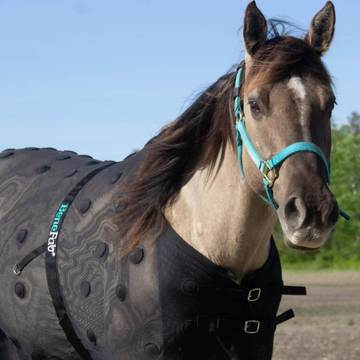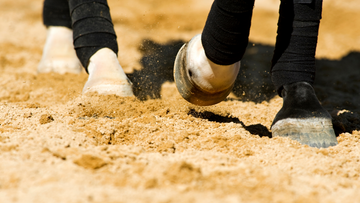Windpuffs, also known as synovial swellings, are a common concern among horse owners and riders. These soft, fluid-filled swellings occur around the fetlock joint of a horse and might cause worry due to their appearance. However, it is essential to understand their cause, severity, and treatment options to ensure the horse's well-being.
In most cases, windpuffs are harmless and result from excessive fluid production in the synovial tissues, which can be attributed to natural wear and tear, strenuous exercise, or prior injuries. The horse's age, level of activity, and overall conformation may contribute to the development of these swellings.
While windpuffs are generally not a cause for alarm, occasionally, they may indicate underlying issues in the joint, such as inflammation or degeneration. Accurate diagnosis is vital to determine if any medical intervention is necessary, as well as to establish appropriate management strategies for the horse's care.
Understanding Windpuffs
 Windpuffs are a common issue in horses that are often noticed as soft, fluid-filled swellings around the fetlock joint. These swellings, which may also be referred to as "windgalls" or "road puffs," are typically painless for the horse and are usually not a cause for concern. Understanding the causes and anatomy can help horse owners and caregivers manage and monitor windpuffs more effectively.
Windpuffs are a common issue in horses that are often noticed as soft, fluid-filled swellings around the fetlock joint. These swellings, which may also be referred to as "windgalls" or "road puffs," are typically painless for the horse and are usually not a cause for concern. Understanding the causes and anatomy can help horse owners and caregivers manage and monitor windpuffs more effectively.
Causes of Windpuffs
Several contributing factors can lead to the development of windpuffs in horses. Some possible causes include:
-
Excessive work or exercise: Overworking a horse, especially on hard or uneven surfaces, may result in swelling and accumulation of fluid in the tendon sheath or joint.
-
Trauma or injury: A direct blow or strain to the tendon or joint can provoke an inflammatory response leading to windpuff formation.
-
Poor conformation: Some horses may have a higher predisposition to windpuffs due to their anatomical makeup, which may place excessive stress on the joints and tendons during movement.
-
Aging: As horses age, their tendons and joints often experience natural wear and tear, making them more susceptible to developing windpuffs.
Identifying Windpuffs
Windpuffs are soft, fluid-filled swellings that can develop around a horse's fetlock joint, typically affecting the lower legs. They are common in both front and hind legs and are generally harmless. However, in some cases, they may indicate an underlying problem. This section will help you identify windpuffs, understand their signs and symptoms, and ensure a proper diagnosis.
Signs and Symptoms
Horses with windpuffs may show some or none of these symptoms:
- Swelling around the fetlock joint, which could be localized to the digital sheath or the deep digital flexor tendon sheath area.
- Heat or inflammation in the affected area.
- Possible mild lameness, especially in cases with a recent injury or severe inflammation.
It's important to note that, in most cases, windpuffs do not cause lameness or pain, and horses can continue working without any issues. However, any significant heat, pain, or lameness should prompt further examination.
Physical Examination
During a physical examination, focus on the following aspects:
- Evaluate the horse for lameness, specifically looking for signs in the front and hind legs.
- Inspect the horse's fetlock joint for any visible swelling, heat, or inflammation.
- Gently palpate the affected area, checking for pain or discomfort.
A horse with windpuffs will generally not show lameness, and the swelling will be soft, warm, and painless.
Diagnosis
To confirm the diagnosis and rule out any underlying issues, a veterinarian will typically perform an ultrasound, x-ray, and/or physical examination.
Treatment and Management
Non-invasive Treatments
Proper windpuff management starts with consulting a veterinarian to evaluate the horse's condition and recommend the appropriate treatment plan. Common non-invasive treatments to alleviate discomfort and reduce the appearance of these blemishes include:
- Bandaging: Applying compression bandages helps minimize the accumulation of fluid and provides support to the inflamed area. (Try Benefab® Antimicrobial Therapeutic VersiWraps with a 30-Day Money back guarantee!)
- Cold therapy: Cold hosing or ice packs can help reduce inflammation in the affected area.
- Sweats: Applying a sweating agent, such as a poultice, can help draw extra fluid out of the effusion and reduce the size of the windpuff.
- Stall rest: Limiting a horse's activity or providing stall rest can allow time for healing and prevent further injury to the inflamed area.
Medical Interventions
For more severe cases of windpuffs, a veterinarian may recommend medical interventions. These can include:
- Anti-inflammatory drugs: Non-steroidal anti-inflammatory drugs (NSAIDs) can help reduce inflammation and discomfort in the affected area.
- Hyaluronic acid injections: Administering hyaluronic acid directly into the joint can help reduce inflammation and improve joint health.
- Steroid injections: In cases where inflammation persists, a veterinarian may recommend a corticosteroid injection to reduce inflammation and promote healing.
It's essential to involve a DVM in the decision-making process for these medical interventions, as improper use of injections may result in additional complications.
In rare cases where adhesions from chronic windpuffs are causing significant discomfort or interfering with the horse's conformation, a veterinarian may recommend surgery.
Prevention and Long-Term Care
Proper Exercise and Work Schedule
A well-planned exercise routine and work schedule are crucial in preventing windpuffs in horses. Regular exercise helps maintain optimal performance and reduces the risk of tenosynovitis, which can lead to windpuffs. Give your horse adequate turnout to allow free movement, promoting blood flow and reducing strain on the lower limb's soft tissues and bones.
Shoeing and Footing Considerations
Regular shoeing and appropriate footing reduce the risk of windpuffs and protect the fetlock joints from potential injury.
Monitoring for Changes
Be attentive to your horse's legs, monitoring changes in the fetlock area. Early detection of idiopathic tenosynovitis and soreness can potentially prevent windpuffs. Conduct regular lameness exams and pay special attention to the rear legs, where windpuffs commonly occur.
While windpuffs may not pose an immediate threat to a horse's well-being, it is essential to remain vigilant and address any signs of pain, lameness, or other abnormalities. By doing so, horse owners and caretakers can promote long-term health for their equine companions.






















